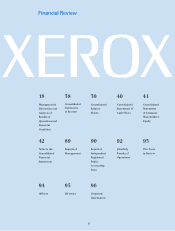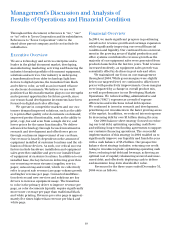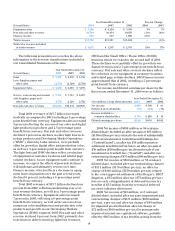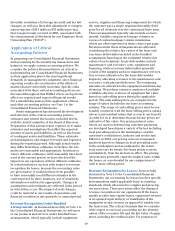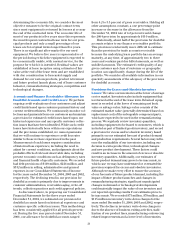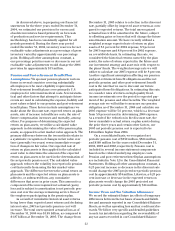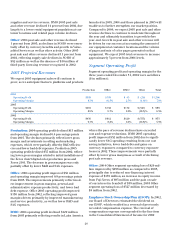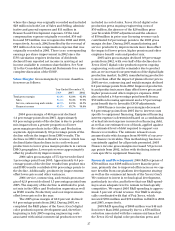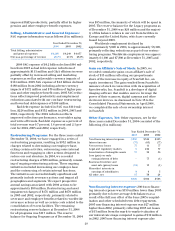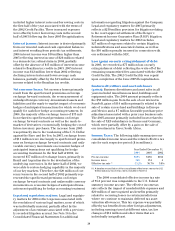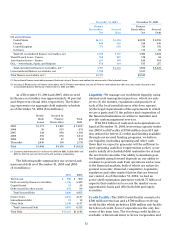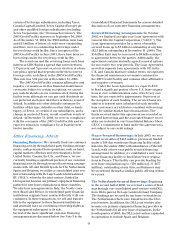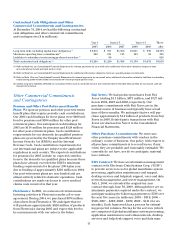Xerox 2004 Annual Report Download - page 27
Download and view the complete annual report
Please find page 27 of the 2004 Xerox annual report below. You can navigate through the pages in the report by either clicking on the pages listed below, or by using the keyword search tool below to find specific information within the annual report.
25
Office: 2004 equipment sales were essentially
unchanged from 2003, as installation growth of
approximately 20 percent and favorable currency of
3-percentage points were offset by moderating price
declines of approximately 6 percent and the impact
of weaker product mix. Product mix reflected an
increased proportion of low-end equipment due to
very strong growth in office monochrome (“Segments
1and 2”) as well as monochrome and color printers.
Color printer growth primarily reflects the success of
the solid ink Phaser®8400, the first product launched
from our new solid ink platform in January 2004, as
well as other color printer introductions.
2003 Office equipment sales increased 5 percent
from 2002, as favorable currency of 7 percentage points
and installation increases more than offset price
declines of approximately 10 percent and the impact of
weaker product mix. Equipment installation growth of
approximately 20percent reflects growth in all mono-
chrome digital and color businesses, particularly office
color printing and monochrome multifunction/copier
systems. The CopyCentre, WorkCentre and WorkCentre
Pro systems, which were launched in the second quar-
ter 2003, expand our market reach and include new
entry-level configurations at more competitiveprices.
DMO: Equipment sales in DMO consist primarily of
segment 1 devices and office printers. Equipment
sales in 2004 increased 8 percent from 2003, primarily
reflecting growth in geographies where we operate an
indirect distribution model such as Russia and Central
and Eastern Europe. This growth was partially offset
bydeclines in Latin America, primarily driven by
Brazil, and product mix to lower segments. During
2004, we accelerated our transition to indirect distri-
bution channels in Latin America to expand market
coverage in that region. DMO 2003 equipment sales
grew 25 percent from 2002, reflecting volume growth
of over 40 percent, partially offset by price declines of
approximately 10 percent and unfavorable mix.
Other: 2004 equipment sales grew 11 percent from
2003, primarily due to growth in equipment sales
associated with our Value-added Services business
and a 2-percentage point currency benefit. Other
2003 equipment sales declined 15 percent from 2002
due to general sales declines, none of which were
individually significant.
Post Sale and Other Revenue
2004 post sale and other revenues of $10.3 billion
declined 1 percent from 2003, including a 4-percent-
age point benefitfrom currency. These declines reflect
lower equipment populations, as post sale revenue is
largely a function of the equipment placed at customer
locations, the volume of prints and copies that our
customers make on that equipment, the mix of color
pages, as well as associated services. 2004 supplies,
paper and other sales of $2.8 billion (included within
post sale and other revenue) increased 2 percent from
2003, primarily reflecting currency benefits which
offset declines in supplies. Supplies sales declined due
to our exit from the SOHO business in 2001. 2004
service, outsourcing and rental revenue of $7.5 billion
declined 3 percent from 2003, as declines in rental
and facilities management revenues more than offset
benefits from currency. Declines in rental revenues
primarily reflect reduced equipment populations
within DMO and declines in facilities management
revenues reflect consolidations by our customers as
well as our prioritization of profitable contracts.
2003 post sale and other revenues of $10.5 billion
declined 4 percent from 2002, including a 5-percentage
point benefitfrom currency, primarily reflecting lower
equipment populations. 2003 supplies, paper and
other sales of $2.7 billion (included within post sale
and other revenue) declined 2 percent from 2002
primarily due to declines in supplies sales resulting
from reduced usage in the lower installed base of
equipment and declines in our SOHObusiness. 2003
service, outsourcing and rental revenue of $7.7 billion
declined 4 percent from 2002, reflecting declines in
rental and facilities management revenues.
Production: 2004 post sale and other revenue
declined 2 percent from 2003, as monochrome
declines, driven primarily bylower page volumes,
offset favorable mix from color page growth of approx-
imately 40percent as well as favorable currency.
Production 2003 post sale and other revenue declined
2 percent from 2002, as favorable currency and
improved mix, driven largely by an increased volume of
color pages, were offset by the impact of monochrome
page volume declines, primarily in older technology
light lens products.
Office: 2004 post sale and other revenue improved
modestly from 2003 as favorable mix to color pages,
digital page growth, and favorable currency were par-
tially offset by declines in older technology light lens
products. Office 2003 post sale and other revenue
grew 1 percent from 2002, as favorable currency and
strong digital page growth more than offset declines
in older technology light lens products.
DMO: 2004 post sale and other revenue declined
7percent from 2003, primarily reflecting Latin
America’s rental equipment population declines. In
response, we have continued our transition to indirect
distribution channels that is intended to increase, over
time, the sales of office devices and the associated




